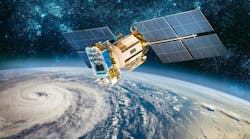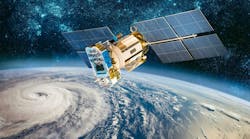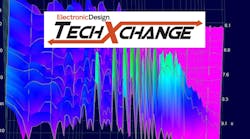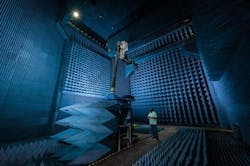NASA’s Strategy to Lower EMI in Outer Space
What you’ll learn:
- NASA’s EMI laboratory performs specification comparisons and analysis of hardware testing.
- How electronic component testing, hardware testing for shielding effectiveness, and the final qualification testing affects experiments.
Outer space can be very dangerous to astronauts and space vehicles, which includes issues with electromagnetic interference (EMI). On that front, the NASA Glenn Research Center EMI labs offer a comparison of specifications along with electronic component testing, final qualification experiment testing, and hardware testing for good shielding reliability and effectiveness.
EMI/EMC and Satellites
Satellites in outer space have a critical function in collecting data and relaying that data to ground stations on planet Earth, typically in real-time.1 When we look closer at this important communications function, we will find that some of these RF frequencies are quite vulnerable to harmful and/or disruptive EMI.
Electromagnetic compatibility (EMC) is necessary for spaceflight hardware designs to guarantee reliable function of spacecraft electronic systems. Not only does it prevent EMI that might compromise communications for mission-critical systems, EMC also safeguards against potential malfunctions caused by electromagnetic disturbances in the complex and harsh void of the space environment.
Thanks to the expertise of the NASA Johnson Space Center (JSC) facilities, EMI/EMC engineering development, evaluation, and simulation is available, along with certification testing for the crew, ground support equipment, and flight. This effort surrounds a vast array of systems that includes communication, biomedical tools, instrumentation, navigation devices and guidance, as well as expert computation and robotics.
>>Download the PDF of this article, and check out this TechXchange for similar articles and videos
Conducted and Radiated Emissions and Susceptibility Testing
The NASA JSC EMI Test Facility (JETF) offers:
- Two independent shielded test facilities with dimensions of 23 × 18 × 10 ft. and 10 × 16 × 8.5 ft.
- Larger equipment-under-test (EUT) assessments are able to be accommodated; however, they will need additional coordination.
JSC’s Anechoic Chamber
Antenna testing is performed in JSC’s Anechoic Chamber. The Antenna Test Facility (ATF) has one anechoic chamber and an outdoor antenna range (see figure).
The JETF tests systems and subsystems in accordance with MIL-STD 461G requirements. Consultation services can be arranged as well to develop a suitable test plan that will meet any test requirements. Some specifics include:
- Shielded chambers, for conducted emissions (CE) and radiated emissions (RE) and susceptibility, have solid engineering support, qualification, and evaluation.
- The JETF supports engineering development and provides EMI/EMC evaluation and qualification.
The JETF facility also enables the testing of crew, ground support equipment, and flight, which includes communication, guidance and navigation, instrumentation, biomedical, computation, and robotics systems.
Flight Computing and Avionics Subsystems
The NASA Johnson Space Center has specialized facilities and expertise in the unique aspects of the design, development, testing, and evaluation of avionics systems and crucial architectures for astronaut space flight.
The Johnson Space Center is a beacon of expertise in the realm of aerospace technology that ranges from data handling and critical commanding architectures to comprehensive component-level analysis and testing.
EMI/EMC and NASA ISS Capabilities
The International Space Station (ISS) serves payload developers with rare research opportunities and the ability to address EMC for payloads.14 It’s critical that the payload developer incorporate exclusive EMC considerations to be compatible with the ISS and all other payloads.
The developer must understand commercial-off-the-shelf (COTS) equipment and components, used in payload designs, to certify that these items will not create EMI issues or compromise any payload performance. Payload developers must contact the ISS Research Integration Office for further information and design guidance in developing electromagnetically compatible payloads for the ISS.
The ISS environment provides unique immunity challenges. However, if the payload developer ignores these challenges, it may impact data collection and technology demonstrations.
ISS EMC and EMI requirements are spelled out in a number of ISS requirements documents:
- SSP 30243: Space Station Requirements, for Electromagnetic Compatibility, are located in the system-level EMC requirements. This is a tailored version of MIL-E-6051D, Electromagnetic Compatibility Requirements, Systems.
- SSP 30245: Space Station Electrical Bonding Requirements, a tailored version of MIL-B-5087B, Bonding, Electrical, and Lightning Protection, for Aerospace Systems.
- SSP 30237: Space Station Electromagnetic Emission and Susceptibility Requirements.
- SSP 30238: Space Station Electromagnetic Techniques, are derived versions of MIL-STD-461B, Electromagnetic Emissions and Susceptibility Requirements for the Control of Electromagnetic Interference and MIL-STD-462, Electromagnetic Emissions and Susceptibility, Test Methods.
- SSP 30242: Space Station Cable/Wire Design and Control Requirements for Electromagnetic Compatibility. These are very similar to DOD-W-83575: Wiring Harness, Space Vehicle, Design and Testing, General Specification, which is a unique document for the ISS. The purpose of this document is to provide a uniform methodology and specification for cabling and wiring to minimize field-to-wire coupling and crosstalk.
- SSP 30240: Space Station Grounding Requirements. This document contains electrical grounding and isolation requirements. The vehicle will use dedicated returns for signals and power. In addition, the vehicle will employ a distributed single ground reference system, or single point ground, to reference power and signals. This will minimize interference and any interactions with the natural plasma and geomagnetic environment, as well as maximize the crew safety.
Mitigating EMI Cost and Exposure
Keeping cost and exposure in check while performing EMI testing on large space vehicles is no easy task. There are many sources of radiation in outer space.8,15,16 The most prominent of these include:
- Solar particle events: Infrequent large increases in particle fluxes are due to solar coronal mass ejections, flares, etc.
- Galactic cosmic rays: Present in all space environments; planetary magnetic fields provide shielding in some orbits.
- Charged particles trapped by planetary magnetic fields.
- Space Plasma environment (including atomic oxygen): Important for surface degradation in some orbits.
Summary: NASA’s Lower-EMI Plan
NASA looks to minimize EMI in outer space both for the protection of astronauts and space vehicle safety. NASA’s JETF is testing systems and subsystems in accordance with MIL-STD-461G. NASA also keeps cost and exposure from radiation low for large space vehicles. Payload developers must incorporate special EMI/EMC considerations while following ISS requirement documents.
References
1. “Effects of electromagnetic fields exposure on the antioxidant defense system,” Elfide Gizem Kıvrak, Kıymet Kübra Yurt, Arife Ahsen Kaplan, Işınsu Alkan, and Gamze Altun, PMC PubMed Central, Aug. 2, 2017.
2. “How Does EMI Affect the Human Body and Brain?,” Steve Taranovich, Electronic Design, 2022.
3. "Deep brain stimulation and electromagnetic interference," US National Library of Medicine, National Institutes of Health.
4. "Electromagnetic Interferences (EMI) and their effect on the nervous system," Dr. Nagi Hatoum, M.D., MSEE.
5. "Effect of Electromagnetic Interference on Human Body Communication," IEEE Transactions on Electromagnetic Compatibility, Vol. 59, No. 1, February 2017.
6. “How Does EMI Affect Various Electronic Systems? (Part 1),” Steve Taranovich, Electronic Design, April 5, 2023.
7. “What Is Electromagnetic Interference (EMI)? How Can You Protect Your Devices Against It?,” Jayric Maning, November 4, 2022.
8. “EMI Mitigation on NASA Spacecraft,” Electronic Design, Steve Taranovich, October 19, 2021.
9. “How Does EMI Affect Various Electronic Systems? (Part 2),” Steve Taranovich, Electronic Design, April 27, 2023
10. “Electromagnetic Interference with Space Systems,” Research contributed by William Campbell, University of Adelaide, www.spacesecurityindex.org, November 2020.
11. “Electromagnetic Interference Laboratory,” Glenn Research Center, NASA, February 11,2021.
12. “EMI/EMC,” Johnson Space Center, February 12, 2024
13. Department of Defense Interface Standard, Requirements for the Control of Electromagnetic Interference Characteristics of Subsystems and Equipment, MIL-STD-461G, December 11, 2015.
14. “Electromagnetic Compatibility Considerations for International Space Station Payload Developers,” George C. Marshall Space Flight Center: Matthew McCollum, NASA; Larry Kim, Jacobs Space Exploration Group; Christopher Lowe, Jacobs Space Exploration Group.
15. “Affordable Electro-Magnetic Interference (EMI) Testing on Large Space Vehicles,” Edward Aldridge, Bruce Curry, Lockheed Martin Space Systems Company; Robert Scully, NASA, Johnson Space Center, TX.
16. “Radiation Environment Effects on Spacecraft,” Ray Ladbury, Radiation Effects and Analysis Group, NASA Goddard Space Flight Center, 2017.
17. “EMI from Spacecraft Docking Systems: Spacecraft Charging, Plasma Contact Potentials,” John Norgard, Robert Scully NASA/JSC; Randall Musselman, US Air Force Academy, Electrical and Computer Engineering (ECE) Department.
18. “Electromagnetic Interference/Compatibility (EMI/EMC) Control Test and Measurement Facility, National Aeronautics and Space Administration,” Lyndon B. Johnson Space Center, Houston, Texas 77058.




